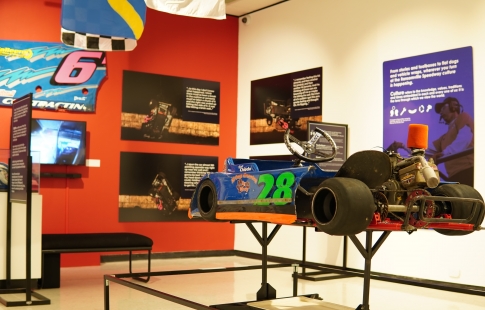Ransomville Speedway Collection
The Ransomville Speedway: Dirt Track Workers in Western New York
View the Ransomville Speedway collection at the Library of Congress

The Occupational Folklife Project (OFP) is an initiative by the American Folklife Center at the Library of Congress dedicated to preserving the culture of American workers.
In 2020, Edward Y. Millar, Curator of Folk Arts at the Castellani Art Museum of Niagara University received an Archie Green Fellowship from the American Folklife Center at the Library of Congress to document the occupational folklife of the Ransomville Speedway, a storied dirt track in Ransomville, New York.
Millar interviewed workers from different sectors of 'The Big R' to raise awareness of the wide breadth of occupational knowledge and practices that facilitate dirt track racing.
The full collection consists of 17 hour-long audio interviews recorded from 2020-2021; over 100 photographs by track photographer Tom Stevens; and scanned historic photographs, rosters, and meeting notes, as well as other ephemera from the early years of the track dating back to the Ransomville Slow Pokes club, courtesy of Jipp and Rick Ortiz.
Each interview covers topics that span the wide breadth of occupational knowledge and practices that facilitate dirt track racing, across almost every area of track operations: from driver slang and the oral history narratives of starters, to the techniques of concession stand workers and motivations of mechanics and crew teams.
Acknowledgements
Special thanks to everyone who participated in the project: Jenn Martin, Jeff Anstett, Erick Rudolph, Tom Stevens, Mike Williams, Don Spatorico, Derek Wagner, April Matson, Dave Botsford, Rick Mooney, Jayme Stone, Dave Rinker, Dakota Miller, Ryan Plante, John Nelson, Jipp Ortiz, Rick Ortiz, and Pete Bicknell.
Castellani Art Museum Exhibition

Installation photo of The Ransomville Speedway: History, Community, and Culture exhibition (2021).
In 2021, the Castellani Art Museum developed an exhibition based off fieldwork collected through the Archie Green Fellowship called The Ransomville Speedway: History, Community, and Culture.
This exhibition highlighted the major themes and topics that emerged from the interviews recorded through the project: the fondly-held memories, the importance of community, and the breadth and depth of cultural knowledge.
The Ransomville Speedway: History, Community, and Culture featured large-format interpretive panels, a slideshow of historic photographs, historic ephemera including early scorebooks and Slow Pokes member patches, flags, door panels, excerpted quotation panels from project participants, and multimedia footage from inside a dirt modified.